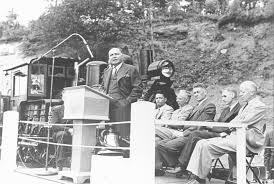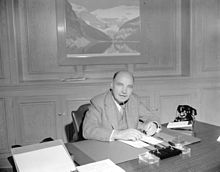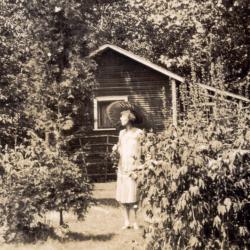#64 Growth of a Man
December 16th, 2016
ESSAY: For good or ill, Harvey Reginald (H.R.) MacMillan (1885-1976) is a name synonymous with the forestry business in British Columbia. Those with a flagging or limited memory will have some minimal sense of H.R. MacMillan through his generous bequest of the H.R. MacMillan Planetarium in Vancouver or the MacMillan Building at University of British Columbia.
As well, as a wealthy industrialist, MacMillan purchased, when few were interested or inclined, many indigenous artefacts. For those who drive to Port Alberni on Vancouver Island, he preserved Cathedral Grove, a wondrous enclave of old growth Douglas Fir timber that bears MacMillan’s name.
But what of his private life? The MacMillan Bloedel Story: Empire of Wood (1982) by Donald MacKay and HR: A Biography of H.R. MacMillan (1995) by Ken Drushka (the latter tome more comprehensive than the former) provide two views of MacMillan’s life, starting from a small, farming town in Ontario.
His is a classic rags-to-riches tale. MacMillan began his vocational life in B.C. as the first Chief Forester in 1912. When WW II ended, MacMillan launched the first privately-owned lumber export brokerage in B.C. of substantive significance. A bumper crop was in the making and, by 1951, MacMillan joined Bloedel, Stewart and Welch to form MacMillan Bloedel. He became a dominant lumber baron for decades afterwards.
Lesser-known than the relatively contemporary biographies of MacMillan by MacKay and Drushka is a novel based on MacMillan’s life, Growth of a Man, by his cousin Mazo de la Roche, best known as the author of the sixteen Jalna novels that track and trace the Whiteoaks family. The first of these novels, Jalna, was published in 1927 and won the annual Atlantic Monthly award—whereupon de la Roche was ushered, immediately, into the larger North American and English literary ethos.
MacKay merely glances over the relationship between de la Roche and MacMillan and the novel, whereas Drushka delves much deeper into their pasts and de la Roche’s Growth of a Man. But so far, the story behind the story called Growth of a Man has been given precious little scrutiny. For those who take the trouble to find it, there can be little doubt that Growth of a Man is one of de la Roche’s finest novels, but her success with the Jalna novels has tended to crowd out some of her better writings.
In 1935, when H.R. MacMillan made a trip to England, Mazo de la Roche and Caroline Clement (who was both MacMillan and de la Roche’s cousin) were living in England. By this time MacMillan had long since surpassed his poor boy status ad de la Roche had published five novels in the Jalna series (Jalna: 1927, Whiteoaks of Jalna: 1929, Finch’s Fortune: 1931, The Master of Jalna: 1933 and Young Renny: 1935).
MacMillan’s visit was an engaging one. The three cousins had much time to ponder and reflect on their younger years. It was just a matter of months before de la Roche conceived of doing a novelistic biography (part fact, part fiction) of MacMillan’s origins and development.
Mazo de la Roche sent many a letter to MacMillan upon his return to the West Coast confirming a multiplicity of facts about their earlier years together, and MacMillan was ample and generous with his replies. The lively, voluminous and engaging correspondence between de la Roche and MacMillan from 1935-1937 has never been fully examined and explored, and a book is waiting some diligent scholar to do their needful deed. Much would be illuminated about MacMillan, de la Roche and Canada if such work was undertaken.
This lengthy correspondence between de la Roche and MacMillan in the mid-1930s became, in many ways, the raw material for Growth of a Man, published in 1938. These days there are precious few people alive who have read it.
The novel is packed with the best of de la Roche’s writing style: inward probes, deft descriptions of human relationships and the natural world, and, of course, intricate probes into the private world of its fictional protagonist, Shaw Manifold. After his father’s death, his mother does her best to find work to provide for the young Shaw. Life on the farm is dreary and Shaw wants a larger life. De la Roche follows Manifold’s focussed life in studies (with the highest of marks) in the agricultural and forestry business.
The novel touches on a variety of friendships and relationships that Shaw had, including courting and romantic possibilities that wax and wane until Shaw does find his life partner. There is a vigorous and demanding realism about the novel that, in many ways, makes it one of de la Roche’s finest works of fact and fiction.
There are tragic and painful patches in the novel that the young and aspiring Shaw Manifold must endure. The forestry industry was emerging in the 1920s-1930s and Shaw’s interest in trees took him to places (via education and government jobs) he scarcely could have imagined as a young boy.
Growth of a Man is de la Roche at her historic and imaginative best, threading together the complex journey of a boy on his way to manhood, breaking free from the constraints of parochial farm life in Ontario in late 19th century and reaching far beyond the dreams of relatives and many of his friends.
The novel is not pure biography—de la Roche took literary license with her Shaw Manifold-HR MacMillan composite, but the affinities are obvious. Those who have reduced MacMillan to merely a ruthless business lumber lord will be introduced to a man with many aspects to him.
In twenty-eight chapters and 400 pages, de la Roche, devotes most of her attention to Shaw Manifold’s early and formative years. It is only in the last couple of chapters in Growth of a Man that Shaw Manifold roots himself in B.C. Therefore decades of preparation for his vocation as a forester and lumber baron are probed in exquisite psychological detail and depth.
Growth of a Man assists the reader in understanding the ambitious nature of MacMillan-Shaw Manifold. It is understandable why MacMillan, upon reading the draft, commented, “For some strange reason I feel some discomfort in attempting to read a book which uncovers some of my ‘danger’ spots and I suppose causes me to feel self-conscious or sensitive.” (letter by HRN to de la Roche: November 11, 1937).
Nonetheless, MacMillan also wrote, “Needless to say, I feel highly complimented by your having chosen me for any part of one of your outstanding Canadian series. (HRM to de la Roche: November 11, 1937).
She responded: “I hope the book justifies your expectations and adds at least one more leaf to your laurels. (HRM to de la Roche: November 11, 1937)
The literary and artistic world of de la Roche and Clement was, in many ways, at odds with the more nouveau riche and entrepreneurial ethos of MacMillan, family and business associates. All three shared memories of earlier years, but paths had parted for a variety of cultural reasons—their friendships, at one level, did continue.
MacMillan did invite and coax de la Roche and Clement not only to visit B.C. but to also move to B.C. The fact that Clement and de la Roche made plans to make the move from Ontario to B.C. in the early-mid 1940s speaks much about the seeming friendship between the three cousins, but when push came to shove, MacMillan did little to support his cousins westward move.
There is a blistering letter by de la Roche to MacMillan (February 28 1945) in which she bluntly takes him to task for his sheer lack of following through on invitations made. The letter begins, “We both agree you have treated us very badly….For years you have expatiated on the benefits of our living in British Columbia”. This letter is relentless in nudging MacMillan to deeper honesty to acknowledge the hospitality offered but never rendered.
*
H.R. MacMillan almost had an association with the leftist firebrand poet, Dorothy Livesay.
In the mid-to-late 1920s, when Mazo de la Roche and Caroline Clement lived in Trail Cottage, in Clarkson, Ontario, Dorothy Livesay, as a young woman, lived across the street from Trail Cottage with her parents. De la Roche and Clement were often in the Livesay home, and Dorothy had many a meeting with the two women.
Livesay moved to Vancouver in 1935, and from 1951-1953 she was at University of British Columbia. If H.R. MacMillan had facilitated the move by de la Roche and Clement to the Lower Mainland in 1945, as promised, Livesay and the Trail Cottage cousins would have met again. After Mazo de la Roche died in 1961, Dorothy Livesay wrote two fine articles on Mazo de la Roche in Canadian Literature (Winter 1965 & Spring 1967).
*
Mazo de la Roche and Dorothy Livesay
Mazo de la Roche and Dorothy Livesay: High Tory Meets Radical
“I am sure, she (de la Roche) was yearning to be known for her other-than-Jalna writing.” —
Dorothy Livesay (1979) ‘Foreward’: Mazo de la Roche: Selected Stories of Mazo de la Roche
The publication of Daniel Bratton’s Thirty-Two Short Views of Mazo de la Roche: A Biographical Essay (1996) did much to revive and, Phoenix like, resurrect the waning and almost forgotten image and vision of the important Canadian novelist, Mazo de la Roche. It is important to note that Mazo de la Roche is buried at St. George’s Anglican parish at Sibbald Point just a few feet from where Stephen Leacock, another Canadian High Tory writer, is buried. Timothy Findley pondered this fact and the affectionate affinities that Leacock and de la Roche might have had in his humorous and speculative essay, ‘Riding Off in All Directions: A Few Wild Words in Search of Stephen Leacock’. But, these are the amusements for another day.
The recent publications by Heather Kirk have further aroused interest in Mazo de la Roche. Kirk has dared to raise some interpretive and challenging questions about de la Roche in both Mazo de la Roche: Rich and Famous (2006) and Who were the Whiteoaks and Where was Jalna? (2007).The points raised by Kirk deserve an ample hearing. But, what has this to do with Dorothy Livesay and Mazo de la Roche?
Dorothy Livesay was known most of her literary life as a radical and often associated with various forms of socialism and communism, although, in fact, she was more of a social democrat or a soft left liberal. Livesay’s brief, vivid and incomplete autobiography, Journey with My Selves: A Memoir (1991) tells, in graphic and not to be forgotten detail, much about her personal, literary and political journey. What does de la Roche, the author of the classical Jalna series (that embodies a form of lingering Canadian High Toryism) have to do with the more modern and radical Livesay? Is such a meeting common within the Canadian soul and society? The answer to the latter question is an obstinate Yes. Livesay went out of her way many times to defend de la Roche when all the emerging liberal literary critics attempted to curtly dismiss her as a relic of the past.
When Mazo de le Roche and Caroline Clement lived at Trail Cottage for varied periods of time in Clarkson, Ontario (between 1926-1932), Dorothy’s Livesay’s parents (Fred and Florence) lived quite close to them-they were perched atop a ravine in a well forested area. Dorothy Livesay was born in 1909, so she was in her late teens-early twenties, and a budding poet, when she met Mazo de la Roche. In fact, Livesay was 18 when de la Roche was catapulted to North American literary fame in 1927 with the $10,000:00 Atlantic Monthly award for Jalna. The Livesay home in Clarkson was a bustling place in which many of the up and coming Canadian literati tested their mettle and wares. Both of Livesay’s parents were front and centre in the literary and media ethos, and the Livesay home was a literary salon of sorts. De la Roche was a relatively unknown Canadian novelist at the time (she had published a few books), and she spent many an hour and day bent over paper with creative pen in hand, and she often visited the Livesay home when she was writing Jalna-her daily path walk to Clarkson for milk and mail meant she passed the nearby Livesay home. All this changed, though, with the award in 1927. The Jalna tradition and novels had been launched. They were only completed in 1960 with the publication of the 16th novel in the series. The Jalna tale of the Whiteoaks family is, probably, the finest and fullest epic written in Canada, and it is rather sad that so few Canadians know about Mazo de la Roche or have read the Jalna novels.
I mentioned above that it became rather trendy for many self styled intellectuals to mock or ignore Mazo de la Roche, but Dorothy Livesay was always there to come to her defense. In the Winter edition of Canadian Literature (1965), Livesay wrote a lengthy article on de la Roche. De la Roche died in 1961, and it was hunting season on de la Roche. Livesay’s article, ‘The Making of Jalna: A Reminiscence’, walks the reader into and through a more positive read of Mazo de la Roche and the inspiration and setting of the Jalna tradition. Many is the personal story and tale told by Livesay, and many is the warm and affectionate memory. There are no hard or mean spirited things said about de la Roche, and Livesay highlighted the good in the vision that de la Roche was trying to portray in her many novels, plays and short stories.
De la Roche, circa 1935.
Livesay came to the defence of de la Roche again in the Spring edition of Canadian Literature (1967). Ronald Hambleton’s biography of de a Roche, Mazo de la Roche of Jalna had left the publishing press in 1966, and Livesay did a critical book review of it. ‘Mazo Explored’ both applauds the fact a biography is in the hands of interested readers, but questions how seriously Hambleton’s approach should be taken. There was much missing in this initial biography, and there were some serious errors, and Livesay thought this should be noted and known for posterity. In short, Hambleton and future de la Roche scholars, Livesay made clear, had much more work yet to do before a finer and subtler understanding of de la Roche would appear.
The 20th century witnessed the rise of a form of literary criticism that was more concerned with the author than the creative work of the artist. Works of literature were read and interpreted through the lens of the artist’s life, dispositions, faults and failings of personality. A classic discussion of this highly charged debate is the missive by E.M. Tillyard and C.S. Lewis: The Personal Heresy (1939). Mazo de la Roche suffered from this approach by some critics, and again it was Dorothy Livesay who came to the aid and assistance of de la Roche. Livesay’s article in Impulse (1973), ‘Getting it Straight’, goes after those who abused and misread the Jalna tradition and de la Roche’s other novels. Livesay defended the importance of female authors (of which de la Roche was a successful pioneer) as much as she defended good literature and the worldview and ethos that fine literature evokes. Most literary critics are quite unaware of ‘Getting it Straight’, and the essay speaks much about de la Roche, Livesay, Canadian literature and the state of Canadian literary criticism in the early 1970s.
De la Roche became so identified with the Jalna series that many were quite unaware that she wrote many other novels, short stories and plays. There was an attempt to correct this failing with the publication of de la Roche: Selected Stories of Mazo de la Roche (1979). Dorothy Livesay penned the ‘Foreward’ to de la Roche. Many are the incisive comments made in the ‘Foreward’ by Livesay about de la Roche. There is a sense in the essay in which Livesay attempted to clarify how her approach to literature was different from de la Roche’s, how de la Roche’s larger literary vision has become distorted by reducing it to the Jalna series, and the need to read de la Roche from a fuller perspective. Livesay made this telling comment:
“Yet all the while, I am sure, she was yearning to be known or her other-than-Jalna writing….Hardy and Dickens remained her heroes.”
Livesay suggested that de la Roche became, to some degree, a victim of her successful Jalna writings, but there was much more to de la Roche (before and throughout the decades of the many Jalna novels) than the life and times of the Whiteoaks of Jalna. De la Roche did publish twenty-one other books other than the Jalna series, and if an honest and fair read of de la Roche is ever going to be done, it is to these short stories, novels, plays and biographies the reader must turn.
Livesay ended her article, ‘The Making of Jalna: Reminiscences’, with these telling reflections:
“My last talk with Mazo la Roche was a gentle one, on the personal family level of the early days. The war was over and I had a little girl of my own whom Mazo and her half sister wanted to see. Miss Clement, alas, was nearly blind by then, and Mazo was the one who must read to her. We were invited to tea in their charming house, glittering throughout with coloured glass. They spoke with particular affection of my father, the erratic ‘Squire of Woodlot’, and of the thousands of daffodils and narcissi he had planted under the white birches at Clarkson. But by now our beloved woodland had been cut up, paved, made into suburbia: and we lamented the old days in
Ontario when people did live as English landed gentry.”
My family lives near Clarkson where Benares (a source of the Jalna novels) and the Livesay home still stands. It is quite possible to walk, as Mazo de la Roche would have done in the 1920s, milk pail in hand and dog Bunty by her side, along the forested ravine trail, past the Livesay home, to the small village of Clarkson. Such a stroll takes the curious into a period of Canadian culture and literary life that Mazo de la Roche and Dorothy Livesay knew well.
It is rare these days to see a radical poet come to the aid of a High Tory, but Dorothy Livesay did this for Mazo de la Roche in four articles published between 1965-1979. Canada has a civic and civil tradition that transcends the tribalism of political ideology, and in many ways de la Roche and Livesay embodied such a sane and civilized way. May we learn much from such grace and graciousness.
*
Ron Dart of Abbotsford has taught in the department of political science/philosophy/religious studies at University of the Fraser Valley since 1990, undertaken Ph.D studies at McMaster University and served on staff with Amnesty International in the 1980s in B.C. He is a leading authority on the subject of Canadian High–Red Toryism, and some of its most significant thinkers, including Stephen Leacock and George Grant. His 25th book The North American High Tory Tradition (American Anglican Press, 2016) has a foreword from Jonathan M. Paquette of the University of St Andrews Institute of Intellectual History. It was celebrated with a public event sponsored by American Anglican Press and the George Grant Society.
*
The Ormsby Review. More Readers. More Reviews. More Often.
Reviews Editor: Richard Mackie
Reviews Publisher: Alan Twigg
The Ormsby Review is hosted by Simon Fraser University.
—
BC BookWorld
ABCBookWorld
BCBookLook
BC BookAwards
The Literary Map of B.C.
The Ormsby Review









It’s the Bloedel Conservatory not the MacMillan Planetarium, that is situated on Little Mountain. The planetarium is in Kits near the water, at the park with the giant crab, if I recall correctly (haven’t lived in Vancouver for 30 + years but I know there’s no planetarium atop Little Mountain).